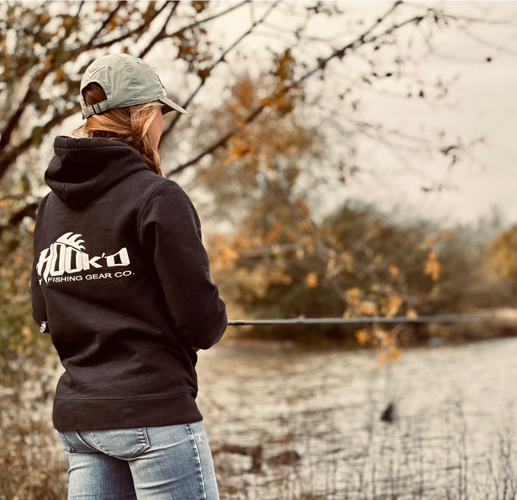Jerkbait 101

I once heard Matt Allen of Tactical Bassin’ say something to the effect of, “If you don’t like fishing a jerkbait, then you’re probably not using it correctly”. That’s not to say that personal preference doesn’t have its place, but it’s certainly something to consider if you’re just not catching fish on it. The suspending jerkbait is a year-round lure that every bass angler should know how to use. It dives down and suspends in the water column to target suspended fish, making it especially effective in the cooler months of the year. Its erratic, darting action mimics a dying baitfish, and can trigger a bite from bass in almost any situation, even when they are not actively looking to feed.
I initially learned secondhand the success that comes with good jerkbait fishing through a Fishbrain friend, who, as evidenced by his winter catch log, could catch more fish in the dead of winter than many of us catch in the warmer months. (Disclaimer: I live in Texas, so the bass bite is year-round here). He made it look so easy, and I had unreasonably high expectations when I took it out on the water for the first time. It was a cold January day and I set out with a Megabass Vision 110 and a handful of tips I’d received on how to use it. Twitch, twitch, pause. Twitch, twitch, pause, as I’d been told. This went on for as long as I could stand before I headed home in defeat, without so much as a bite. Winter fishing is not called tough for nothing. I learned the lesson that if you’re trying to learn a new technique, the middle of winter is perhaps not the best time to gauge its effectiveness.
I didn’t give the jerkbait another try until fall. Determined to have success, I tied it on one day and didn’t use anything else until I’d caught something on it. Five fish later I felt like I’d sort of gotten the hang of it, and I’ve had a hard time putting it down since. My success with it still pales in comparison to that of my Fishbrain friend, but I have caught many bass on it when I couldn’t get a bite on anything else, and I consider that success in and of itself. If you’re looking to try fishing a jerkbait for the first time, or just to gain more confidence with it, now is an excellent time to throw it. Prespawn is here (or just around the corner) for many of us, and the jerkbait is a tried-and-true lure to fish this time of year, with feeding activity increasing as the temperatures rise. Below are some tips to help you get started.
Rod
I use a 6’11” medium spinning rod. I know many people prefer a baitcaster, but I find a spinning rod to be more comfortable. Whatever your preference, I recommend a medium power rod – it will help with both casting distance and setting the hook without too much force.
Line
Light line is key in jerkbait fishing. Small diameter fluorocarbon is nearly invisible in the water, which is crucial during those pauses when a bass can get a good look at your lure, and it assists in better action and suspension than the more buoyant monofilament. 10-12 lb fluorocarbon is my recommendation.
Working the lure
Make a long cast and reel the jerkbait down to the desired or maximum depth. Make quick downward twitches with your rod, and then pause. The cadence will vary depending on what bass are in the mood for. Mix it up. Twitch one, two, or three times, and then pause. In warmer water, you might pause for a couple of seconds. In cold water, 10 seconds or longer may be needed. Make sure to always leave some slack in your line when working a jerkbait – this allows for a more erratic, side-to-side action on the twitches, while leaving it to sit in one place on the pause. You’ll want to snap the rod tip back and forth – too much tension on your line and your jerkbait will swim rather than dart. Practice is key – you will get a feel for managing your slack the more you do it. And watch your line closely as you may not feel the bite on a pause due to the slack.
Hookset
As with other treble-hooked lures, use a side-sweeping hookset. Setting the hook too hard and fast can rip the hooks out of the fish’s mouth.
Selecting a Jerkbait
There are many factors that go into jerkbait selection: depth, action, profile, weight-transfer, color, etc; and it can seem overwhelming if you’re just getting started. The most important aspect is to select an appropriate diving depth according to the water you fish. A shallow jerkbait will dive 3-5 feet, which is what I use for bank fishing. The gold standard according to most bass anglers, the Megabass Vision 110, comes in a variety of options but has a hefty price tag of $25. If you’re just starting out, spend what your budget allows and know that a cheaper option isn’t going to prevent you from learning. I received a set of Yo-Zuri 3DB 110s from a Tackle Warehouse giveaway and I love them. These run around $10. At a similar price point, I also love the Rapala Shadow Rap.
(A note on soft plastic jerkbaits: if you are fishing thick cover and getting hung up, a soft plastic jerkbait, or fluke, is a great weedless option. I use a drop-shot or wacky rig hook and run it through the head of the fluke, burying the hook tip in the nose. I fish it exactly like a hard jerkbait on the same setup.)
In summary, the jerkbait is a great year-round lure that deserves a spot in every bass angler’s tackle box. It can be tricky to learn at first, but like anything it just requires practice, patience, and making small adjustments until you find success. If you’ve been hesitant to try a jerkbait, I hope these tips will be helpful to you.
Happy fishing, and remember that time on the water is the best way to learn!




